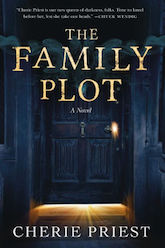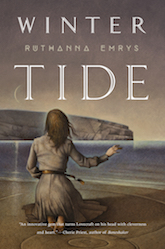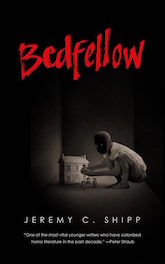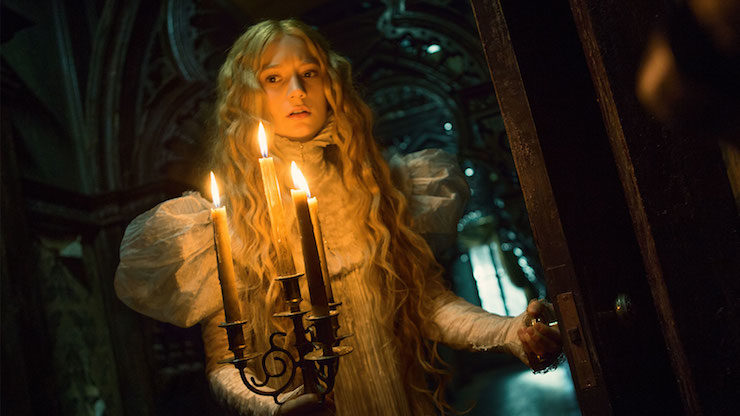The woman wears a long velvet dressing gown over a lace peignoir that froths around her ankles like seafoam as she runs across the moor. In the distance, the shape of a house grown vast and gloriously terrible beyond any architect’s dreams looms, bleak and menacing and wonderful. The moon is high enough to light the scene; the sun is a lie told by nannies to their charges to keep them from being afraid of the monsters in the night. The monsters are not a lie. The monsters are real. The monsters are already inside the house. The monsters are in the blood and the bone and walls, the monsters are here, the monsters are pursuing the woman through the heather, toward the cliffs overlooking the sea, the monsters are sitting down in the parlor for slices of cake and cups of tea.
Welcome to the gothic horror.
Generally accepted to have originated in England with The Castle of Otranto (1764), the gothic horror genre balances in a strange hinterland between modern horror and fairy tale, pulling in elements of romance, realism, and the German Räuberroman, or “robber novel.” It is a genre where houses have hearts that can be broken and corrupted, where families wither under the weight of terrible secrets spanning generations, where lightning can do anything, and where women flee across the moors at the slightest provocation, and generally without pausing to put on sensible shoes. It ranges from the truly supernatural, filled with vampires and werewolves and men who always sound to me like Vincent Price in his heyday, to what is called the “explained supernatural,” a genre conceit which most people are probably familiar with from the various adventures of Scooby-Doo and the gang.
(One can, in fact, make a strong case for various of Scooby’s spinoffs being true gothic horror tales. The quantity of horror is not dictated by the genre, only the nature of the horror, and whether you’re looking at something like Scooby-Doo, Where Are You!, which belongs firmly to the explained supernatural/robber novel camp, or something like the more recent Scooby-Doo: Mystery Incorporated serials, which are modern gothic horror by almost any measure, the nature of the horror itself is very much in the gothic vein.)
I’m fond of saying that there are absolute genres and genres that are as much about the mood and feeling of the story as they are about following strict rules. This division, imprecise as it is, is what allows for mix-and-match genres. Science fiction, for example, requires a certain amount of technology beyond our own: things that were science fiction twenty years ago may be modern fiction today, as innovation catches up to and passes by them. Horror, which is more of a mood than a set of absolute rules, becomes the overlay that can be slapped onto almost any absolute genre. Science fiction horror? Got it: Alien, Cabin Fever. Fantasy horror? Wishmaster, Troll. Horror adds to what’s already there. It modifies and accents.
Think of it this way. Some genres build the house. Other genres come along and decorate it.
Gothic horror is a very decorative genre.
In fact, given the negotiability of its supernatural elements, gothic horror is almost entirely about the décor. What matters is the nightgown you wear while you flee from danger: what matters is the moonlight on the moors. It’s impossible to nail any genre down to “every single example will contain this thing”: there’s always an exception. So let’s go with “these are the most common elements of the gothic horror” instead of “these are the things you must have or we won’t allow you to come to our tea party.”
Buy the Book


The Family Plot
First, you’re going to need some architecture. Creepy old houses, abandoned abbeys, even a nicely outfitted windmill can feed into your gothic design. (Abandoned amusement parks and hotels will usually be more of a modern horror thing, although there are always exceptions. Carnivals and creepy circuses have their own set of rules when they’re being used as a horror setting, so while, say, The Vampire’s Apprentice may trend toward the gothic, I’d argue that it’s more closely related to Something Wicked This Way Comes than it is to Dracula.) This is a genre that’s all about the aesthetic, and you want to move it into the Addams Family mansion as quickly as possible. Some gothic horror that’s all about the architecture:
- The Haunting of Hill House, Shirley Jackson. Good, classic, evil house story. We like us a nice evil house.
- The Family Plot, Cherie Priest. Trending a bit into Southern gothic, which has some of its own rules, but another clean, classic haunted house.
- The Shining, Stephen King. Remember how I said there were always exceptions? King’s Overlook is so lovingly antiquated that it straddles the line, and can absolutely be read as a gothic horror setting.
Next, you’re going to need to set the mood. Gothic horror will almost always include some form of journey by night, whether it be our eponymous heroine fleeing in her impractical footwear, or a wild dash down narrow roads to escape some act of villainy, the darker and bleaker things get, the better. (This is potentially one of the reasons that modern gothic horror can be so difficult to pull off. The more modern you go, the harder it can be to find a way to kill the lights when the time comes.) Honestly, this is such a consistent element that it would be easier to make a list of gothic horror that doesn’t contain some element of the nighttime journey. This is also an aspect of why vampire fiction fits so well into gothic horror: when your fun stuff always happens at night, it’s harder to notice that your love interest never comes out during the day.
Buy the Book


Winter Tide
Now you’re going to need a sweet, fainting ingenue. The further back you go, the more consistently this will be a virginal young woman, but we live in the modern world now, and we can have male and non-binary and genderfluid ingenues, too (and I would like five dozen, right now, thanks). This is the innocent protagonist whose struggles will somehow define the story, either because they’re being hunted by a vampire or courted by the wicked heir to an even more wicked local noble, or because they’ve been sent to a remote manor house to raise a new generation of mysterious, isolated gentry. These are our Marilyn Munsters, our Daphnes, our Mina Harkers. Let’s meet a few of them:
- Aphra, Winter Tide and Deep Roots, Ruthanna Emrys. Yes, a work can be Lovecraftian and gothic at the same time, and while Aphra is no child, she is in many ways both cause and catalyst of her story.
- Julia, Julia, Peter Straub. The ingenue doesn’t have to be a virgin, or a child: she can simply be someone who doesn’t deserve the situation in which she finds herself. Julia embodies so much of this trope.
- Lisa Carew, Jekyll & Hyde, Frank Wildhorn and Leslie Bricusse. Yes, the musical; look for the original two-disk concept album, not the revival production. This show is gothic horror to the core, and hearing it may help you find the groove in which it thrives.
Who wants a villain? Yes, a villain. A monster or a wicked member of the clergy or a conniving noble, you have so many choices here. Again, it’s the aesthetic that matters as much as the motivation here. A few examples:
- Claude Frollo, The Hunchback of Notre Dame, Disney Pictures. I had to fit this in somewhere, because this is Disney’s most gothic work. The mood, the framing, even the structure of the plot, it all fits.
- Dracula, Dracula, Bram Stoker. He just wants to make some friends, y’all. And eat some pretty ladies.
- Lestat, Interview With the Vampire, Anne Rice. Whether Lestat is a villain, a victim, or a plucky protagonist depends partially on where you enter the series. Regardless of where he falls from page to page, he’s a key part of the plan.
Really, if you want to see what the gothic horror aesthetic looks like when taken to its logical extremes, look at two seemingly dissimilar but connected properties: The Addams Family (in any incarnation), and Crimson Peak, by Guillermo del Toro. Both are beautiful examples of the aesthetic that makes them part of “gothic horror,” draped artfully across a house of a more architectural drama (family comedy, in most cases of the former; actual horror, in the case of the latter).
Buy the Book


Bedfellow
So why does gothic horror endure? It’s not unique among the annals of sub-genres: there have been dozens that popped up, centered around a narrow time period, a delicate set of cultural constraints, only to disappear again as the world moved on. Westerns are not as common as they used to be. Steampunk is still doing amazing things, but it changes and adapts to stay alive, while gothic horror is content to sit in its cobweb-strewn sitting rooms, sipping tea and talking about the weather. It doesn’t make sense.
Except that it does. Gothic horror was an intentional extension of the Romantic school, making it as much a sub-genre of romance as it is of horror. It is, in some ways, a very conservative genre: while things may not end happily, we know that when they’re over, the sun will rise, the family will be reunited in one way or another, the walls will stand, and whatever walks there will walk alone. Gothic horror is comforting, like an embrace from a large, mothball-scented blanket that may or may not come to life at night and devour people who try to break into the house. It says “there are rules, and you will come to understand them, given time.” It says “we will love you as you are, even if you’re a talking Great Dane.” It says “come home.”
Come home.
The mystery is, as always, waiting for you.
 Seanan McGuire is the author of the October Daye urban fantasy series, the InCryptid series, and several other works, both standalone and in trilogies. She lives in a creaky old farmhouse in Northern California, and was the winner of the 2010 John W. Campbell Award for Best New Writer. In 2013 she became the first person ever to appear fives times on the same Hugo ballot. The Wayward Children novella series —Every Heart a Doorway, Down Among the Sticks and Bones, Beneath the Sugar Sky and the forthcoming In an Absent Dream—is available from Tor.com Publishing.
Seanan McGuire is the author of the October Daye urban fantasy series, the InCryptid series, and several other works, both standalone and in trilogies. She lives in a creaky old farmhouse in Northern California, and was the winner of the 2010 John W. Campbell Award for Best New Writer. In 2013 she became the first person ever to appear fives times on the same Hugo ballot. The Wayward Children novella series —Every Heart a Doorway, Down Among the Sticks and Bones, Beneath the Sugar Sky and the forthcoming In an Absent Dream—is available from Tor.com Publishing.










